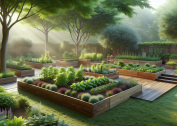Explore how vertical gardening opens new possibilities for compact homes and small outdoor areas. This guide reveals ways to maximize your living space, use sustainable materials, and cultivate a lush garden—even in the smallest settings. Discover the essentials for creating a beautiful vertical green wall.
Why Vertical Gardening Appeals to Small Space Dwellers
Vertical gardening has surged in popularity as more people embrace apartment living and seek clever ways to add greenery without sacrificing precious floor space. Mounting plants on walls, using stackable planters, and installing trellises can turn patios or city balconies into vibrant retreats. This approach is transformative for those living in urban settings, where private gardens are rare but the desire for green surroundings persists. With vertical gardening, every blank wall or narrow nook becomes a potential canvas for lush growth, making green spaces more accessible for everyone (Source: https://www.epa.gov/green-infrastructure/what-green-infrastructure).
Vertical gardens offer benefits beyond aesthetics. They can insulate homes, help control temperature fluctuations, and promote better air quality indoors and out. Research shows that living walls and green roofs can reduce noise pollution and improve urban biodiversity. These gardens help maximize photosynthesis in smaller areas, while clever irrigation systems conserve water more efficiently than traditional ground gardens. For people renting or living in condos, portable vertical structures offer flexibility and are easy to move if relocation is needed (Source: https://www.nps.gov/tps/sustainability/new-technology/green-roofs.htm).
Community gardens are also adopting vertical gardening techniques to increase harvests in tight quarters, reduce weed problems, and create visually striking communal spaces. Apartment complexes and urban schools have utilized vertical planters for educational gardens, empowering residents and students to grow herbs, salad greens, and even small fruiting plants. The flexibility and scalability of vertical setups remove many barriers that kept people from gardening before, democratizing access to fresh, healthy produce.
Designing a Vertical Garden: Structure and Plant Selection
Choosing the right vertical gardening system depends on the space, structural support available, and intended use. Wall-mounted panels, freestanding towers, and modular hydroponic units are all viable. Homeowners sometimes build trellises or pergolas, while renters often prefer lightweight, pocket-based planters or recycled materials like pallets. Vertical gardens can feature edible plants, trailing flowers, succulents, or even ferns—whatever suits the local conditions and desired look (Source: https://hgic.clemson.edu/factsheet/gardening-indoors-using-hydroponics/).
Plant choice is critical for long-term success. On sunny balconies, Mediterranean herbs like rosemary, oregano, and thyme will thrive, while shadier walls can support leafy greens, ferns, or shade-tolerant flowering varieties. Lightweight potting mixes and slow-release fertilizers nourish roots in restricted growing spaces. Gardeners often mix perennials and annuals for seasonal color and reliability. Wherever possible, using native plant species can provide habitat for pollinators and ensure better adaptation to local climates.
It is important to factor in structural integrity, especially when attaching planters to buildings. Drip irrigation systems help reduce maintenance while keeping roots consistently moist. Some creative gardeners even upcycle shoe organizers for strawberry towers or hang old gutters for cascading lettuce. Carefully plan the arrangement for aesthetics and sunlight access. Plants that trail gracefully downward soften vertical lines, while upright growers fill in gaps and create full coverage.
Sustainable Practices in Vertical Gardening
Many vertical gardeners prioritize eco-friendly materials and sustainable watering systems in their projects. Upcycling old pallets, using biodegradable pots, or installing rainwater harvesting help lessen environmental impact. Drip irrigation and hydroponic towers are famous for water efficiency, delivering moisture directly to roots and cutting waste. These practices also minimize nutrient runoff, which is a problem in traditional gardening (Source: https://www.epa.gov/watersense/outdoor/rainwater-harvesting).
Soil health is a concern with vertical installations, as shallow pockets can dry out faster. To counteract this, many gardeners mix organic matter such as coco coir or compost into lightweight soils. Mulching the top of vertical planters can also help reduce evaporation and maintain even temperatures. Companion planting, which involves placing plants that benefit each other in close proximity, can boost pest resistance and overall resilience of the vertical garden.
For spaces with limited natural sunlight, some use energy-efficient LED grow lights to supplement light and support plant health. These lights can be run on timers or integrated with solar panels for an extra boost of sustainability. By considering water cycles, plant nutrition, and the energy inputs of the overall system, a vertical garden can be both beautiful and eco-responsible, offering inspiration for the larger community.
Vertical Gardens Indoors: Bringing Nature Home
Indoor vertical gardens—often called living walls—can dramatically change the atmosphere of a home. Mounted on a kitchen wall, living room, or entryway, they provide lush scenery and a sense of tranquility. An indoor vertical garden is a creative solution for those without outdoor space or in climates with harsh winters. These gardens can be modular and tailored to fit any wall, large or small (Source: https://extension.psu.edu/indoor-plants-for-indoor-air-quality).
Many indoor vertical gardens feature air-purifying plants such as pothos, spider plants, or philodendrons, which research has shown can naturally filter out certain indoor pollutants. Besides improving air, they offer visual appeal that can reduce stress and enhance well-being. Maintenance is simplified with self-watering systems, and most designs allow for easy reconfiguration, so individuals can swap plants or adjust layouts seasonally.
Lighting and humidity play major roles in keeping indoor vertical gardens healthy. Some setups include built-in LED lights to provide adequate illumination, especially in windowless rooms. Grouping plants by their water needs streamlines care. Many urban dwellers report that tending a living wall gives them a daily connection to nature, even when surrounded by concrete outside.
Common Challenges and Solutions for Vertical Garden Success
Vertical gardens have specific needs, and some growers face challenges such as uneven watering, root crowding, or pest outbreaks. Drip irrigation and capillary mats are helpful for consistent moisture. It is vital to check planters regularly for clogged hoses, root rot, or mold growth—issues exacerbated by restricted airflow or overwatering. Proactive monitoring is key to early detection and intervention (Source: https://gardeningsolutions.ifas.ufl.edu/plants/flowers-and-ornamentals/vertical-gardens.html).
Nutrient management is another hurdle, as vertically arranged plants may not have access to deep or diverse soils. Liquid or slow-release granular fertilizers are often applied at intervals, but over-application should be avoided to prevent salt buildup. Periodically replacing some plants or replenishing soil materials will keep growth vigorous and reduce long-term maintenance headaches.
Pests and diseases can sometimes spread more quickly in compact garden systems. Integrated pest management, such as introducing beneficial insects or using organic sprays, helps keep populations in check. Choosing disease-resistant plants and rotating varieties seasonally can also limit outbreaks. For renters, portable systems minimize the risk and make experimenting with different layouts easier.
Creative Inspiration: Vertical Garden Examples to Spark Ideas
Vertical gardens can take many shapes and forms. Some urban gardeners transform chain-link fences into edible walls by hanging fabric pocket planters filled with herbs and greens. On patios, stacked terracotta pots allow for multi-tiered displays of succulents and small annual flowers. A well-placed trellis or arched frame may support climbing beans, peas, or clematis, giving a burst of height and drama to the space (Source: https://www.missouribotanicalgarden.org/gardens-gardening/your-garden/help-for-the-home-gardener/advice-tips-resources/gardening-help-faqs/vertical-gardening).
Some homeowners design living art by arranging decorative mosses or bromeliads in eye-catching geometric patterns. Indoors, modular felt walls host aromatic kitchen herbs right beside the dining table. Schoolchildren have built living towers from recycled bottles, learning hands-on about sustainability, recycling, and plant biology. These projects can be collaborative, encouraging creativity while addressing practical needs.
For those who love DIY, building a custom panel with reclaimed materials or crafting a vertical succulent frame is both rewarding and economical. Vertical gardening not only beautifies spaces but also inspires community pride and environmental stewardship. Each living wall—no matter the size—adds vibrancy and demonstrates that anyone can become a gardener, regardless of space limitations.
References
1. U.S. Environmental Protection Agency. (n.d.). What is Green Infrastructure? Retrieved from https://www.epa.gov/green-infrastructure/what-green-infrastructure
2. National Park Service. (n.d.). Green Roofs. Retrieved from https://www.nps.gov/tps/sustainability/new-technology/green-roofs.htm
3. Clemson Cooperative Extension. (n.d.). Gardening Indoors Using Hydroponics. Retrieved from https://hgic.clemson.edu/factsheet/gardening-indoors-using-hydroponics/
4. U.S. Environmental Protection Agency. (n.d.). Rainwater Harvesting. Retrieved from https://www.epa.gov/watersense/outdoor/rainwater-harvesting
5. PennState Extension. (n.d.). Indoor Plants for Indoor Air Quality. Retrieved from https://extension.psu.edu/indoor-plants-for-indoor-air-quality
6. University of Florida IFAS Extension. (n.d.). Vertical Gardens. Retrieved from https://gardeningsolutions.ifas.ufl.edu/plants/flowers-and-ornamentals/vertical-gardens.html









